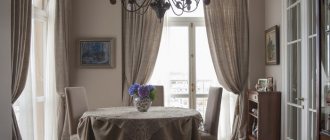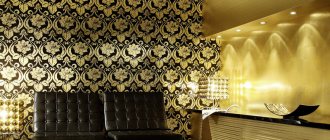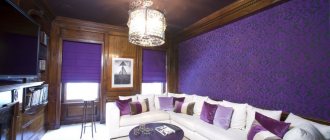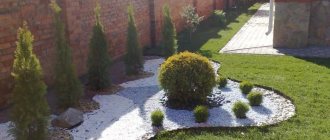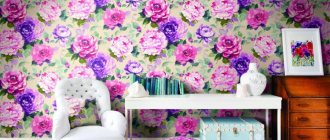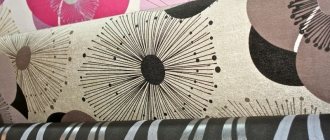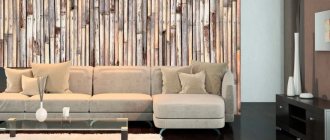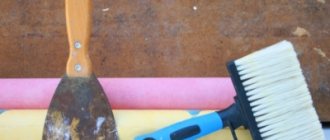Everything flows and changes, including the world of wallpaper. Recently, along with traditional ones, rolls called meter rolls have appeared on sale. For their manufacture, different materials are used: non-woven fabric, paper, fabric, bamboo. Having undoubted advantages, they have not yet found the scale of application that they deserve. People are accustomed to the standard 53-centimeter width. Or maybe it’s worth moving away from stereotypes and learning how to hang meter-long wallpaper correctly and beautifully?
Advantages and disadvantages
The term “meter-long wallpaper” is conventional: under this name you can find 90-centimeter rolls and tubes much wider than a meter. Belgian manufacturers, for example, produce canvases reaching a width of 1.4 m.
Meter wallpaper came to us from abroad, where their advantages have long been appreciated:
- They make the pasting better, reducing the number of joints on the walls by at least half.
- They save effort and time: it’s easier to cut and stick 5 strips of meter-long wallpaper instead of 9–10 standard sizes.
- They are cheaper than traditional material: the price of one wide tube is less than the cost of two standard ones.
Flaws:
- Can only be placed on a flat surface: if there are defects, good joining of the wallpaper panels cannot be achieved.
- Consumption, compared to standard ones, may increase: due to a strip of several centimeters, you will have to buy an additional wide roll.
- It is difficult, sometimes completely unrealistic, to paste meter-long wallpaper alone.
Standard sizes
Knowing the size of the wallpaper, it will be possible to calculate the exact quantity for covering a particular room. At the same time, there are standard indicators, the width and length of which are the most common.
The fabrics are packaged in rolls that look like large tubes. The greater the thickness of the coating, the wider the diameter of the product. The generally accepted standards include the most popular sizes that are sold on any construction market.
Standard coating dimensions
Standard width canvases make up the main range. The width of such a roll is 0.53 m and the height is 10.05 m. There are also wide wallpapers for walls, their width is higher than usual and is 1.06 m.
Tools and materials
To work you will need:
- pencil;
- plumb line;
- tape measure or measuring tape;
- roller or spatula;
- masking tape;
- wide brush;
- knife;
- clean rag or sponge.
If there are significant flaws in the surfaces to be pasted, you will need putty, primer, and sandpaper.
You need to take care of the wallpaper glue in advance. When choosing it, do not forget that different types of wallpaper (non-woven for painting, paper, vinyl and others) require their own type of adhesive.
Preliminary preparation of walls
The base for meter-long wallpaper should be perfectly flat. The operations themselves are traditional, but they must be carried out with special care so that insoluble problems with joining the wallpaper do not arise later.
- Nails, screws, self-tapping screws are removed from the walls, switches and sockets are removed, and the holes are sealed with masking tape.
- The old coating is removed: wallpaper, plaster, paint, etc. How to do this correctly is described in this article.
- The next stage is cleaning the walls with sandpaper.
- For serious unevenness, you will have to use putty.
- The surface is covered with 1–2 layers of primer. This way it will not absorb wallpaper glue, and the adhesion of the canvas to the wall will improve.
- If you plan to glue non-woven wallpaper, which tends to show through, apply a white primer or paint last.
USEFUL INFORMATION: Different types of wall painting
Advice: you can start applying glue to the base only after the primer has become completely dry.
Marking walls and cutting canvases
Wide wallpaper is glued end-to-end, so work can begin from any convenient place.
- To ensure that the first strip lies on the wall as evenly as possible, a vertical line is drawn using a plumb line and a pencil. This will become the starting point for the sticker.
- Before cutting begins, it would be a good idea to measure the length of the wall and determine the number of strips that will fit on it.
- When cutting, you need to leave a margin of 10 cm at the top and bottom of each wallpaper. Don't forget about the allowance for matching the pattern. Excess can be easily removed with a sharp knife after the glue has dried.
- The rolls are rolled out on a dry, clean surface face down and the required length is measured. Having made a notch, bend and cut along the resulting seam.
Important! High humidity in the room where wallpaper is being applied is undesirable. A draft is completely unacceptable; extreme coolness is also contraindicated. It is best to glue at a temperature of 15–25˚С.
How to calculate wallpaper footage
- The required number of stripes is determined. First, the perimeter of the room is calculated. The length of adjacent surfaces is measured, the result obtained is multiplied by 2. If the length of one wall is 5 m and the second is 2 m, then the perimeter is (5 + 2) x 2 = 14 m. Since it is planned to glue meter-long canvases, it means that you will need to cut out 14 strips.
- The length of the stripes is calculated. The place in the room with the greatest height between the ceiling and floor is determined. The length of this section is multiplied by 14. If the ceiling height is 3 m, multiply by 14 and get 42 m. This is the minimum required total length of the canvases. If the room has windows, doors or other structures, it is better not to subtract their size from the figure obtained during calculations, so that the material is purchased with a reserve.
- Counting the number of rolls. The total length of wallpaper is divided by the length of 1 roll, the resulting figure is rounded up. If there are 10 m in 1 roll, 42 m is divided by 10 m, you get 4.2 rolls. So you need 5 rolls. It is recommended to take 1-2 more rolls in reserve for future repairs, replacing areas that have been soiled or torn by animals or children. In total you need to buy 7 rolls.
Sticker process
Depending on the type, meter-long wallpaper is attached in different ways:
- Paper canvases. The material is first coated with glue, then the sticker is applied to a dry base.
- Varieties on non-woven base. The technology is exactly the opposite: the wall is covered with glue, the strips are applied to it dry.
- Heavy vinyl wallpaper. Both the wallpaper and the wall are coated with the adhesive.
Baguettes should be placed before gluing begins. Read more about why they should not be installed over the topcoat.
To work with meter-long wallpaper, a partner is needed: the first person holds one edge of the strip, the second holds it on the opposite side. It is convenient to use two stepladders at once - this makes leveling wallpaper on the walls much easier and faster.
Sequencing:
- Glue is applied to the back side of paper and vinyl wallpaper with a paper base. Non-woven fabrics are left without it. Paper ones are applied to a dry base. For the rest, the glue is applied with a roller to the wall along the width of the wallpaper with an additional grip of approximately 20 cm.
- The joints and corners are carefully coated with a brush. The glue is applied especially well on the top of the wall.
- Begin gluing the cut from the top, aligning it along the intended vertical. To do this, you need to hold the panel by the upper edge, climb the stepladder and attach it strictly to the junction of the ceiling and wall. The partner controls the coincidence with the intended vertical.
- After checking, the strip is leveled with a plastic spatula or rubber roller. The choice of device depends on the type of wallpaper: a hard tool can damage the textured canvas. You should start from the middle of the band, expanding the range of movements: from the center - to the sides, up and down.
- To get rid of air bubbles, carefully smooth the wallpaper from the center to the edges. By pressing with the tip of a spatula, additionally work out the corners and joints of the wallpaper with the baguette and the baseboard.
- A second glue line is applied with the same 20 cm margin. This is necessary so that during further actions the glue does not get on the wallpaper. The next section is glued and joined to the first one.
- After smoothing, you need to go over the joint with a rubber roller.
- All subsequent canvases are glued in a similar manner.
USEFUL INFORMATION: Wall preparation: how to remove old plaster
Advice: you need to put up new wallpaper before the start of the heating season, as the hot air near the radiators wrinkles the wallpaper.
Wallpaper type and size
Coatings from different components are produced in different sizes. When you know the size, sometimes it is possible to determine the type of canvas or vice versa.
Generally accepted production rules are:
- Paper webs are small in size. The width is often standard and is 53 cm.
- Foamed vinyl sheets can be either meter or half meter. Meter versions are produced exclusively with a non-woven backing.
- Hot stamped vinyl products are often made in large widths.
- Most silk fabrics have small widths.
- Materials for further coloring are long and can be produced in different widths.
- If the dimensions do not fit any standard, then vinyl wallpaper made in Europe is used. The cost of such products is quite high and they are often used to implement unusual design solutions.
- The sizes of photo wallpapers may vary; they are indicated on the product packaging.
As you can see from the article, the sizes of wallpaper coverings can vary quite a lot. There are standard solutions with a given width and height, but there are also a large number of other options. So-called meter-long canvases have a number of advantages over half-meter ones; they will significantly simplify the gluing procedure. Using the images used in the article, you can see all the coating options.
Angles
An attempt to decorate a corner with a single piece is guaranteed to lead to failure: it will be skewed, folds without trimming, which will not have the best effect on the appearance of the wallpaper, will be impossible to eliminate. But if this does not happen, the curvature of the angle will certainly disrupt the perpendicularity of the canvas, and then the number of defects will only increase.
Correct actions:
- A strip is cut out 5 cm larger than the width from the corner to the glued wallpaper.
- The wall and corner are carefully coated with glue.
- Wallpaper is glued, placing a 5-centimeter margin on the adjacent side of the corner.
- The narrowest place of the overlap is determined, where a mark is placed at a distance of 1 cm from the edge of the wallpaper, through which a vertical line is drawn.
- With the orientation towards it, the next sheet is glued with an overlap.
- The seam is trimmed using a spatula, ruler, or stationery knife.
Preparation for gluing
People often have questions related to gluing canvases that contain drawings. Ordinary canvases do not require any additional actions: the rolls are glued gradually, regardless of the characteristics of the ornament. Canvases with a pattern, in turn, require caution and care when gluing, since the fragments on the wallpaper must eventually coincide and form a pattern.
By the way, the size of the wallpaper roll also plays an important role here. To glue canvases with a pattern, first of all you need to know the step. A step is a gap on a roll through which the pattern is repeated in an identical manner. Knowing the step, you can calculate the additional materials that will be needed when gluing, since during fitting unnecessary fragments (rapports) will be cut off. If the room being renovated is standard in size, then up to three additional rolls will be needed.
Read more: Installation of a septic tank Tver construction diagrams and installation options
It is worth remembering that the frequency of rapport will affect the number of cuts. Therefore, it is worth choosing designs from a certain number of rolls by combining them. In addition, the rolls must be produced from the same batch, since wallpaper from different batches often has different shades.
Each repair is accompanied not only by the work itself, but also by numerous calculations. Calculating the amount of wallpaper needed to hang a room is no exception. And, before going to a specialized store, you will need to find out some information on the basis of which the calculation will be made, incl. and how many square meters there are in a roll of wallpaper. It is the answer to this question that will help you figure out how much wallpaper is needed for a room with a certain area.
However, for a more complete calculation you will need to take into account some other factors, such as:
- The degree of illumination of the room.
- The condition of its walls.
- The intended purpose of this space.
So, in small spaces, the area of which is no more than 10-15 square meters, it is advisable to use lighter canvases and small, unobtrusive ornaments or patterns. It is this approach that will visually increase the usable space of the room. For slightly more spacious rooms, canvases with patterns that do not differ in sharp contrast are quite suitable.
Likewise, you will need to decide on the choice of stripes. Thus, vertical stripes will help to visually increase the height of the ceiling, “narrowing” the number of square meters of space, while horizontal stripes will be able to create the illusion of a wider space, but the ceilings, in this case, will seem a little lower, almost hanging over your heads. Therefore, this choice will be justified only in cases where the height of the walls is at least 2.8-3 meters.
So, to find out the amount of materials needed, the first thing you need to do is find out the area of the room. And the very number of rolls directly depends on how much wallpaper there is in each of them, calculated per 1 m2.
Batteries
The wallpaper under the window sill is glued last. The work will require patience and accuracy, bordering on virtuosity.
- The wallpaper sheet is cut to the size of the radiator niche.
- Vertical cuts are made in areas coinciding with the battery mounts.
- The glue-coated section is carefully inserted behind the pipes.
- The next task is to straighten the folds formed on the sheet and press it against the wall. Due to the tightness, it is impossible to use a paint roller, so smooth it out using a rag.
- Excess overlap is applied to the edge of already pasted wallpaper.
- Pressing both layers firmly with a spatula, make a vertical cut.
- The joint remaining after removing the cut strips will become invisible when dry.
USEFUL INFORMATION: Is it necessary to prime the walls before puttying?
If such an operation was not possible, cut the wallpaper into smaller pieces and continue pasting the hard-to-reach area.
Sockets and switches
Wallpaper is glued directly onto the holes remaining after removing switches and sockets, the outlines of which will be visible. Then in these places the panel is cut crosswise with a wallpaper knife. The cut sections of wallpaper are tucked inside. For round rosettes, the cuts are made star-shaped.
Some switches cannot be removed without dismantling the entire mechanism. In this case, trimming is carried out without removing the protective panel.
- The wallpaper strip is pasted only up to the switch; with a sharp knife, punctures are made in the corners of its frame, serving as a guide for the cross-shaped cut.
- After cutting, press the edges tightly with a spatula, remove excess, carefully roll the edges to the wall and continue gluing the rest of the panel.
Openings
Wallpaper on doorways is cut off. On arches and windows, they are also cut to the size of the opening, not forgetting to carefully ensure that the pattern is aligned.
Trimming in a window opening
Final trimming
What if you have to glue alone?
Sometimes you can do without an assistant when attaching meter-long wallpaper - non-woven varieties of material will help out, because in this case the glue is applied only to the wall. Non-woven fabric will help you easily join seams even in corners. There are no particular difficulties with aligning the stripes. If it is not possible to glue the sheet correctly right away, the panel is removed and the operation is repeated again - non-woven fabric allows this. But meter-long wallpaper made from other materials will not allow this; a partner is necessary in such cases.
A lesson on gluing wide canvases is in the video below.
How many meters in one roll of wallpaper
Unlike the width of the wallpaper, the length is always the same in the standard version. Of course, there are two additional length options, but such panels are used only in certain cases, which will be discussed below. Thus, the length is:
- 10.05 m is the standard height; finding trellises of this size will not be difficult.
- 15 m is an additional option, which is usually used for vinyl-based panels. Very often, such trellises are produced with a pattern, or are made in a special way for further painting.
- 25 m is another non-traditional option, which can usually be found in non-woven canvases made specifically for painting.

